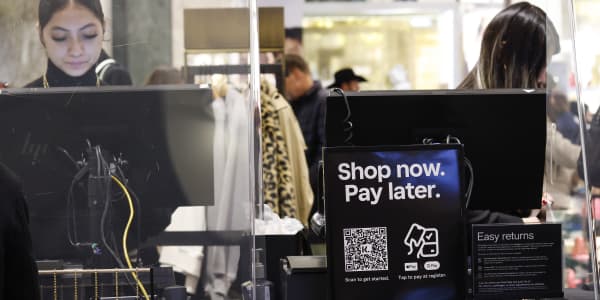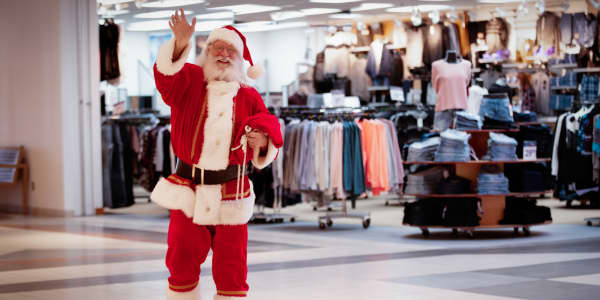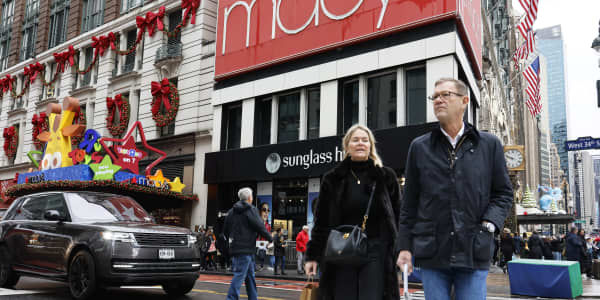Just in time for the holidays: Retail's new tech
Read this email to receive a special offer! Get 50 percent off this weekend only! Earn cash back by making this purchase!
As retailers flood shoppers' devices with the latest promotions, it can be difficult to make a brand's message stand out through all the noise. So some retailers are thinking outside the mailbox, bringing a wave of cool new technologies to the market over the last year.
"Retailers have got to change," said Steve Semenzato, co-founder and vice president of business development for Cortexica, the company behind visual search technology. "The more innovation that they can [manage], the higher the value the company is perceived as having."
That's reigned true for the retail industry this year, with analysts naming tech-focused brands among their favorites. Those include Macy's and Nordstrom, which have seen their shares rise 23 percent and 19 percent over the past year, respectively.
To see of some of the coolest retail technologies that have launched over the past year, click ahead.
—By CNBC's Krystina Gustafson
Posted 20 Nov. 2014
Blue Nile's augmented reality
Want to send your significant other a hint that it's time to pop the question?
Earlier this year, online jewelry destination Blue Nile added augmented reality to its mobile app. Shoppers custom build their own engagement ring by first choosing the shape, clarity and size of the diamond, followed by the setting.
After using their smartphone to snap a photo of their hand, they can then adjust the size and placement of their custom creation to see what it would look like on their hand. From there, they can either purchase the ring through the mobile app, or send the image along via email or text.
Macy's 'Shazam' for shopping
What better way to get shoppers interested in your store than turning the entire world into a showroom?
Macy's teamed up with Cortexica, which provides image recognition and visual search technology, for what's being billed as the "Shazam for shopping."
By opening Macy's app, shoppers can take a snapshot of anything from a pot of flowers to a page out of a magazine. After uploading the image to the app, users select which category they'd like Macy's to search for a similar product. Once it's loaded the search results, shoppers can purchase items directly through the app.
The technology also powers the app Style Thief, which searches hundreds of retailers' databases for similar products.
Lowe's 3-D renovation rooms
If you can't decide what countertop will match the bathroom fixtures you've decided on, Lowe's has the solution.
This holiday season, the home improvement store is launching a 30-by-30 virtual reality room, where shoppers can see a 3-D rendering of their renovation plans before they get started on the project.
Customers first design their ideal room on one of the store's iPads. Then, they step into the "Holoroom."
Any features the shopper doesn't like can be virtually swapped out. Once they're satisfied, customers will receive a list of the items they selected, which can be purchased in-store or on the Web.
The Holoroom will initially cater only to bathroom remodels, but the hope is to expand it to other rooms in the following months.
Also this year, Lowe's announced that it would bring autonomous retail service robots, named OSHbots, to its midtown San Jose, California, Orchard Supply Hardware.
Rebecca Minkoff's high-tech store
Earlier this month, fashion designer Rebecca Minkoff launched her first flagship store, which was built to fuse fashion and technology.
The New York City location prominently features a connected glass shopping wall, powered by eBay, on which customers can digitally browse the store's inventory. They can then use this interactive touch screen to select items, and have them sent to their dressing room. They're notified via text message when the room is ready.
Once inside the fitting room, RFID technology will identify which items are inside. Need another size? No problem. These mirrors are also built with smart technology, and can be used as a touch screen to request a different size.
Design your own shoes at Nordstrom
Nordstrom is taking customization to new heights.
The department store earlier this month announced a partnership with Shoes of Prey, an Australian retailer that lets shoppers customize their own shoes.
Through the company's 3-D designer, which is pulled up in Nordstrom locations on an iPad, women get to choose from 12 different base styles, ranging from ballet flats to extra-high heels. They then select their desired heel height, decorations, materials and color.
For reference, the stores will house swatches for more than 170 materials, and have on hand expert "shoe stylists."
Once purchased, the designs are sent to the customer's home in less than four weeks.
Nordstrom launched its first Shoes of Prey location in its Bellevue, Washington, store, and will roll out the concept to five other locations by the first quarter of 2015.
Kate Spade's shoppable construction zone
Just because a retailer hasn't opened a store shouldn't keep you from shopping the brand.
Last month, Kate Spade launched a new concept at The Mall at Short Hills in New Jersey, whereby shoppers could interact with and make purchases from the label before it cut the ribbon on its new store.
By answering four personality questions spread out across touch screens, the interactive barricades, created by The Science Project, send customers their shopper profile via text or email. They also send along a list of product recommendations, which can be purchased through the website.
Kate Spade has since rolled out the shoppable scaffolding for its Macy's Herald Square shop-in-shop, and plans to open more locations around the U.S. in coming months.
Ugg's tech-powered store
Deckers' Ugg brand is fusing two futuristic concepts at its Tysons Galleria store: interactive touch screens, and the ability for shoppers to add a personal touch to their footwear.
The McLean, Virginia, store is outfitted with four 65-inch high-definition screens, which are triggered by RFID technology that's embedded in every product. To activate these screens, all a customer needs to do is check out their shoes in the mirror. They then offer shoppers different size and color options—as well as style tips—and suggest related products.
Customers can also use the screens to customize five classic Ugg styles.
Sephora's virtual reality mirror
Mirror, mirror on the wall—what's the best eyeshadow of them all?
For shoppers who don't want to try on dozens of testers to find their perfect shade, Sephora has the answer. Earlier this year, it launched in Europe a 3-D augmented reality mirror. By simply touching a palette on the mirror, the color virtually appears on a customer's eyelid.
Similarly, L'Oréal earlier this year launched a "Makeup Genius" app, which allows shoppers to virtually test cosmetics on their mobile devices.
Bloomingdale's smart dressing rooms
Smart fitting rooms are threatening to be a mainstay in the mall of the future.
Bloomingdale's added its name to the list of companies experimenting with the technology, by launching new fitting rooms at five locations around the U.S.
These dressing rooms include wall-mounted tablets that can scan merchandise to let shoppers know what other colors and sizes are available, and give them additional product information.
Shoppers can also tap a button to get assistance without leaving the room.
Whole Foods' finds your perfect pairing
Entertaining can be overwhelming—particularly when you aren't well-versed in which wines taste best with certain cheeses.
To help shoppers out, Whole Foods' Alpharetta, Georgia, location launched a new technology last month that offers advice on things like how much wine you should buy for a party, or how to make your own cheese plate.
The screens, created by Second Story, part of SapientNitro, also feature an "expand your palate" section, which reveals wine and coffee recommendations based on shoppers' taste preferences.





